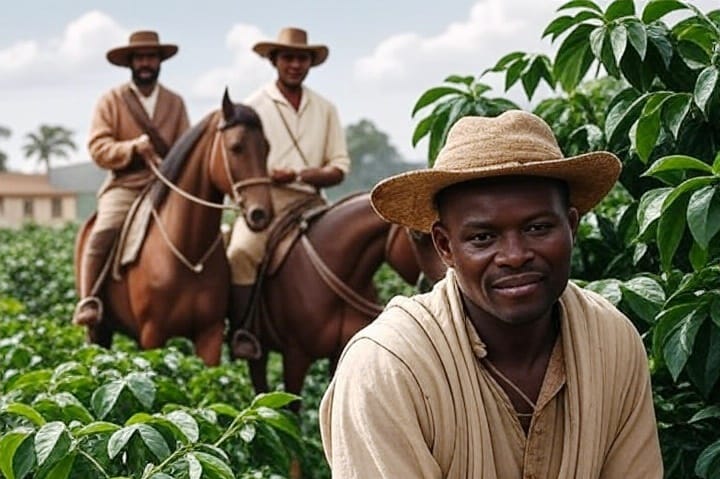🌍 Nationalism in South Africa
The development of nationalism in South Africa was uniquely complex due to:
a) Multiple Colonisers: The country was not colonised by a single European power, leading to competing influences. 🏴🇳🇱
b) Mineral Wealth: The discovery of valuable minerals 💎 like diamonds and gold made European powers more aggressive in their efforts to control the region’s wealth.
This complexity resulted in three distinct types of nationalism emerging:
- British Imperialism 🇬🇧
- Afrikaner Nationalism 🚜
- African Nationalism ✊🏿
🚜 Afrikaner Nationalism
This was the nationalism of the Dutch-speaking settlers (Boers/Afrikaners). It emerged in the 19th century and peaked in 1948 when the Nationalist Party, led by Daniel F. Malan, won the election and introduced the Apartheid policy.
Reasons for its rise:
- 🛡️ Resistance to Anglicisation: A desire to protect Afrikaner culture, language, and identity from being swallowed by British influences.
- 👑 Hatred of British Rule: They viewed British rule as alien and oppressive.
- 🗣️ Cultural Domination: The British dominated politics and society but made no effort to understand the Afrikaner language or way of life.
- 🇿🇦 Desire for Republican Independence: They wanted to rule South Africa themselves, free from British control, believing they had a divine mission to civilise the region.
- ⚔️ The Jameson Raid (1895): A failed British attack on the Boer Republic of Transvaal, which inflamed anti-British sentiments.
- 🤝 The Union of South Africa (1910): The terms of the union that created modern South Africa were seen as favouring British interests.
✊🏿 African Nationalism
This was the resistance and liberation movement of the indigenous African majority. Its roots trace back to the 17th-century wars against Boer occupation (e.g., Xhosa, Ndebele, and Zulu wars). The creation of the Union of South Africa in 1910, which gave political control to whites, stripped Africans of rights like voting. 🗳️❌
Factors for its Growth:
- ⛪ Christianity: Mission teachings about equality contrasted sharply with the racism Africans faced, inspiring a fight for justice.
- 💰 Harsh Economic Exploitation: Land alienation, forced labour, and laws like the Natives Land Act (1913) that restricted land ownership created immense hardship.
- 🌍 Pan-Africanist Influence: Early leaders were inspired by the idea of African self-determination and unity.
- 🚷 The Apartheid System (1948): Legalised racial segregation convinced Africans that only freedom could bring salvation. 🚫
- 📚 Western Education: Educated elites (e.g., Nelson Mandela, Walter Sisulu) could articulate grievances and lead political organisations.
- 🪖 World War II: African soldiers returned home exposed to new ideas and having witnessed the myth of white invincibility shattered.
- ⚒️ Labour Exploitation: Laws like the Mines and Works Act (1911) reserved skilled jobs for whites, trapping Africans in low-wage manual labour.
- 🏙️ Urbanisation: Cities brought different ethnic groups together, helping them unite against a common enemy.
Key Organizations & Events:
- 1912: African National Congress (ANC) is founded 🤝
- Formed in response to oppressive laws by the educated elite.
- First President: John L. Dube.
- Other Founders: Pixley Ka Isaka Seme, Solomon Plaatje.
- Initially moderate, but became more militant over time.
- 1943: ANC Youth League Formed 🔥
- Led by Nelson Mandela, Walter Sisulu, and Oliver Tambo.
- Advocated for a more assertive approach to liberation.
- 1955: The Freedom Charter 📜
- Adopted at the Congress of the People, it declared that “South Africa belongs to all who live in it, black and white.”
- 1959: Pan-Africanist Congress (PAC) Splits Off ➗
- Led by Robert Sobukwe, who felt the ANC was too multi-racial.
- 1960: Sharpeville Massacre 💔
- PAC protesters against pass laws; police opened fire, killing 69+ people.
- The ANC and PAC were banned.
- 1960s: Turn to Armed Struggle ⚔️
- ANC’s armed wing: Umkhonto we Sizwe (Spear of the Nation).
- PAC’s armed wing: Poqo (Blacks Only).
- Key leaders like Mandela and Sisulu were arrested and jailed for life in the Rivonia Trial (1963-64). 🔒
- 1970s: Black Consciousness Movement ✊🏿
- Led by Steve Biko, focused on psychological liberation and black pride.
- 1976: Soweto Uprising 🎓➡️🔥
- Students protested against being taught in Afrikaans.
- Police responded with violence, killing hundreds.
- 1977: Steve Biko was killed in police custody, becoming a global martyr. ☠️
🏁 The Peak: Road to Democracy (1980s-1990s)
- 1983: The government’s new constitution proposed a tri-cameral parliament, still excluding Africans. It was widely rejected. 👎
- 1983: United Democratic Front (UDF) was formed, led by figures like Desmond Tutu 👨🏾🦳, to coordinate internal anti-apartheid resistance.
- 1989: F.W. de Klerk became president and began dismantling apartheid. 🕊️
- 1990: De Klerk unbanned the ANC & PAC and freed Nelson Mandela after 27 years in prison. 🙌
- 1991: The core apartheid laws were repealed. 📝➡️🗑️
- 1993: Violence threatened the transition (e.g., ** assassination of Chris Hani**). 🔪
- April 1994: South Africa’s First Democratic Elections ✅
- The ANC won a majority.
- Nelson Mandela became the first black president. 🇿🇦👑
In Summary, South Africa’s journey from a state of complex, competing nationalisms to a unified “Rainbow Nation” 🏳️🌈 was long and bloody, ultimately triumphing over the oppressive system of apartheid.

